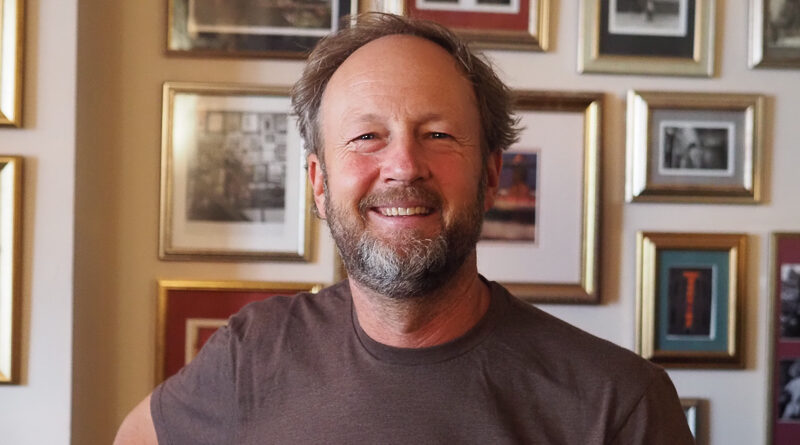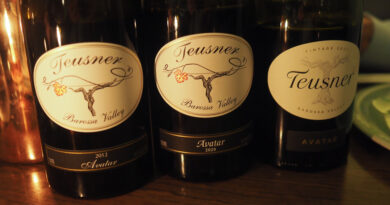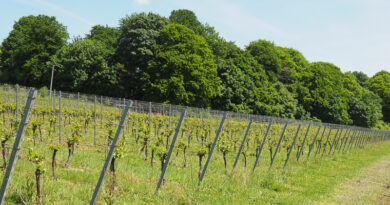Matthiasson: a masterclass in modern viticulture with Steve and Jill, plus tasting their wines
Steve Matthiasson is a farmer first, winemaker second. With his wife Jill, they look after several vineyards in Napa and Sonoma, and make unusually balanced wines for this part of the world. I caught up with them on a visit to London to hear the story of their journey into organic and regenerative farming. ‘Regenerative farming is something that is near and dear to our heart,’ says Steve Matthiasson. ‘it’s something that we have been working with our whole careers. We weren’t a winery that got into organic farming; we were organic farming nuts that got into wine.’
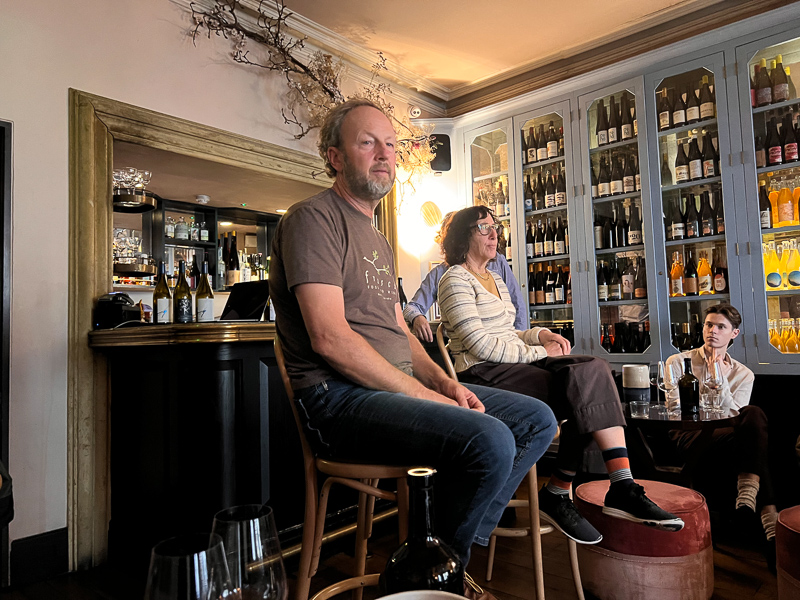
‘We both worked at the student farm in UC Davis that was started back in the 1970s with a lot of idealism,’ says Steve. ‘The model was to work towards a more sustainable agriculture. It is a goal or process that we are continually working towards, which requires more knowledge, technology, techniques and information sharing. There is a lot more that needs to come before we get to some semblance of sustainability. It is something we aspire towards.’
‘The endpoint isn’t fixed,’ says Jill Matthiasson. ‘It is always moving. Carbon footprint isn’t something we talked about 30 years ago. The social part of it is something we have always talked about, but there are always new metrics.’
‘I was working for a small consulting company that farmers were hiring to reduce their pesticide and fertilizer use, and reduce their irrigation, or to transition to organic, or to farm organically more successfully,’ says Steve. ‘There was a lot of counting bugs on leaves, taking soil samples, and trying to work with them to find out how to deal with their problems in a less chemically intensive manner. The crops were almonds, walnuts, peaches and grapes.’
‘I was still finishing grad school,’ says Steve. ‘I thought: I’m working in vineyards now so let’s get some grapes from the student vineyard and make wine. The first wine we made in 1995 was Muscat of Hamburg. We weren’t wine people. We were organic farming type of people. We wanted to do something cool and unusual that we’d never heard of before, and we were at UC Davis, one of the great agricultural schools of the world who have a collection of grape vines. They have probably 500 varieties. So we thought Muscat of Hamburg is really delicious, so let’s try to make wine from it. This was our mindset going in. Now we make wine from 25 different varieties and a lot of people in the wine world are aghast at that.’
‘A lot of our friends who became winemakers, but it wasn’t in the family, at least grew up drinking wine, but this wasn’t our case,’ says Jill. ‘Neither of our parents drunk wine. We started a journey learning about wine and making wine all at the same time.’ How have things changed in farming in California since they started in 1995? ‘Now, most farming operations in the state of California will claim that they are sustainable,’ says Steve. ‘If you ask them, they can list a handful of things that they are doing. They might be growing a cover crop, or they are monitoring soil moisture before irrigating, or they are monitoring for their bugs before they are spraying. This is a huge shift in mentality, because in the 1990s they would poo poo the whole concept of sustainability. That’s all hippy crap, they’d say. The fact that the whole industry adopts the moniker is a massive shift. Have they fundamentally changed how they do things? Not really. But there are some changes.’
‘Jill did her master’s degree on cover crops about 30 years ago, and all through the 1990s it was about trying to convince farmers to plant cover crops. Everyone thought that if you had anything growing between the vines it would suck the life out of them, the yields would suffer, and that you would have to keep everything clean cultivated. I’d say we are at the point where 95% of the vineyards in the state of California plant a cover crop in the winter, and this is huge. It’s a massive win because the benefits of cover crops are tremendous. There is more water infiltration, there is some carbon sequestration no matter what your tillage regime is, there is less erosion, there is a bit of extra habitat even if you till it in in the spring. But then there are other things: people don’t want to give up their pesticide.’
‘And their glyphosate,’ says Jill. ‘It’s interesting,’ says Steve. ‘Glyphosate/Roundup replaced a whole suite of worse herbicides. A lot of the pre-emergent herbicides are very long lasting in the soil and they get into aquifers and streams. They are really bad for invertebrates and frogs. It was a big push to get rid of then and move to glyphosate in the 1990s as a more sustainable alternative. A lot of farmers feel hurt that they made all these changes, and now the last 20 years they have been feeling virtuous that they have only been using roundup, and now for people to say Roundup is so evil, they say: make up your mind.’
‘They are switching back to preemergents now they don’t use roundup any more,’ says Jill.
‘There has been a fixation on Roundup rather than a fixation on herbicide use,’ says Steve. ‘There are a lot worse herbicides that people are going back to. Weedkillers are pretty much all bad, but Roundup is one of the least toxic. People talk about systemic fungicides damaging some of the fungal mycelia in the soil. I’m not aware about any research to that effect. The thing about soil bacteria is that they love to eat pesticides. My guess is that any fungicides would get eaten before they have any affect on the fungi living in the soil. The fungi can be pretty deep and the fungicides degrade quickly. The problem we have with pre-emergent herbicides is that they are formulated to not be eaten by the soil bacteria. Most pesticides are eaten by soil bacteria so they have to figure out how to put chlorines or different chemicals onto the rings to block the bacteria from getting at that carbon. They sit around in the soil and when a weed germinates it sucks it up and dies. This is why they are so environmentally catastrophic, because since they don’t get broken down they get washed away.’
There is a huge problem with systemic fungicides and people because they hang out inside the tissue, and this is more of a people/worker issue. There’s another thing: I think that vines need to have a bit of disease pressure to stimulate their immune system, and I think the wine quality is better. There are more of the secondary metabolites we want – more ripeness at lower sugar levels. This is a bit more speculative. Systemic pesticides are a whole other thing because there are these new systemic pesticides that move in the phloem. This is a huge innovation so it is taking over agriculture. If it moves in the phloem it can get into the pollen and nectar, and nectar-feeding insects consume it. So we are seeing huge die-offs of bees and other beneficial insects. This is a huge concern.’
One of the arguments against organics is that you can’t feed the world with organic farming, but Steve and Jill’s experience with the Linda Vista vineyard has been that organics has increased yields. ‘It is on a high-clay loamy soil that’s of marine origin,’ says Steve. Most of Napa is volcanic, but there are some marine uplifts, and this one portion has marine clay with high water-holding capacity. The loamy soil has potential for high production.
‘This vineyard was planted back in the 1980s by Beringer,’ says Steve, and over time weedkillers and fertilizers, plus changing hands a few times, meant it wasn’t producing well. ‘It was considered a tear-out. We talked to the new owners in 2011 and asked to take it over,’ he says. ‘We converted it to organic farming, deep-ripped the soil to break up the compaction, and got compost on where weedkillers had been for three decades. Within three years we tripled the yield on these vineyards,’ says Steve. ‘It was really exciting to see these old vines come back. It is amazing what unlocking the potential of the soil can do.’
Steve was hired to help write the sustainability protocol in Lodi in 1999, and when this work finished he went to Napa to start his own consultancy in 2002. One of his first clients was George Vare. ‘He was a retired high-level winery guy,’ says Steve. ‘Unlike most of those guys, who are often cynical about wine, he was passionate. For his retirmenet he decided he was going to grow Ribolla Giala and start a winery with his daughter. This was his favourite variety and he smuggled over Ribolla Giala cuttings that Gravner gave him. When I first started working for him I thought what the hell is Ribola Gialla. We came up out of farming, and for us it has been a journey learning the world of wine after making our own wine. We just fell in love with it. It was such an interesting grape. He was making skin-macerated Ribola Gialla in 2003. I didn’t know you could make white wine on the skins. George and I travelled to Friuli, and Jill didn’t get to go. I remember calling her: we were going to make a Sauvignon Blanc Semillon blend for Matthiasson, which we’d started in 2003. In 2005 I was in Friuli and called Jill, and asked her to cancel it. My mind was blown by the white wines of Friuli. We were sold on Ribolla. We made our first white wine in 2005 and it was a Ribola Gialla/Sauvignon Blanc/Semillon/Friulano blend.’
‘Then we bought our first vineyard in 2006. At that time George was bottling cancer and we thought if he dies and his vineyard is sold they will rip out the Ribolla immediately to plant Cabernet, so we grafted some cuttings into the vineyard that we purchased. We started making wine from that: our first crop was 2008 and it was whole cluster fermented. We do the skin fermented every year. Terroir is so interesting but it’s part of the picture. Grape varieties are interesting too. With other crops, like heirloom apples, if it’s a Spitzenburg apple people love the fact that it’s a spitzenburg apple. If it’s in New York, people say Spitzenburg apples have this lovely crunchy acidity, but we don’t forget that it’s the apple, this cutting that people have been passing on for a long time. We are interested in varieties.’
‘We became known for Ribolla Giala’, says Jill. ‘People started paying attention to what we were doing a bit more, because it was so unusual, especially coming from Napa. It put us on the map a bit. In 2008 no one was doing a skin contact white and talking about it. It was very hard to sell this wine for a long time. Then orange wines became a thing and we started selling out pretty quickly.’
In terms of regenerative practices, putting the right variety in the right place is key, says Steve. ‘If you put a high-vigour variety in a high-vigour site, then you are fighting disease pressure. If you put a low vigour variety in a low vigour site, and you are fertilizing, watering and tilling like crazy to get it to grow. We like to fetishize own-rooted vines, but rootstocks are a phenomenal tool for reducing the amount of agricultural inputs you need, because with rootstock you can match the vine to the site so well,’ says Steve. ‘You can put a deep-rooted vigorous rootstock like Paulsen or Ruggeri in a dry site, and in a wet site you can put a shallower-rooted rootstock.’
Jill adds, ‘Coming back to the rootstocks, it is a tool we have for addressing climate change. For years we were fighting vigour in Napa, trying to find ways to devigorate the vines through reducing irrigation and reducing the canopy. Now we have had this drought and we have low vigour vines, our yields are lower, and we are replanting a vineyard we acquired last year because it is badly diseased. We are putting in vigorous rootstocks, in some cases like table grape rootstocks that you’d never have thought of using for high quality grapes. This way we won’t have to irrigate: we think we’ll get away without irrigating by using these high vigour rootstocks. It’s on a hillside and there is no water there.’
‘We have some new rootstocks that have come out from UC Davis,’ says Steve, ‘but they were like 40 years in the making. We are still learning how they work. It is crazy how long it takes. We have been in a 10 year drought in California, so we are looking for high-vigour pest resistant rootstocks. This isn’t what the industry was looking for, for all these years. When you plant a vineyard that’s going to be there for 50 years, how do we predict what the climate will be in 50 years?’ Says Jill. ‘We are making a bet on new vineyards that it is going to be hotter and drier,’ says Steve.
‘I’m very excited about spore trapping,’ says Steve. ‘The problem with powdery mildew is that you can’t see it, but it’s there growing or not (you can’t see it, because it’s such a small amount), but it gets to a critical mass and takes off. So you have to spray preventatively, and you have no idea whether it is actually there or not. You can’t take the chance. The whole industry is spraying preventively whether it is there or not. Now they have spore traps. It looks like a weather station: it is a vacuum pump with a little box. Twice a week we take a tube out of it and we mail it to the company, and they tell us the number of spores it caught. If it is zero, we don’t have to spray. This is massive. Our friend Nick [Gislason], the winemaker at Screaming Eagle, got in really early in the spore trapping. And he hasn’t sprayed a single spray at Screaming Eagle in two years.’
Where is the balance point between the competition for water, and the increased infiltration that comes from having things growing in the soil, and the enhanced water storage capacity that comes with higher organic material in the soil? ‘It is important to understand that regenerative farming practices are site specific,’ says Steve.
‘Start with our climate,’ says Jill. ‘We have six months when we can get rain, and six months where we absolutely have no rain. We have a classic Mediterranean climate. For most of the growing season, from May to November, we get no rain. We might get a storm and have half an inch, but that’s it.’
‘It’s really more extreme than the actual Mediterranean,’ adds Steve. ‘If you get a bit of rain in that six month period, it is like what the hell is this? This is one of the reasons why California has very specific crops. We grow 85% of the almonds in the world because almonds don’t like to get rained on, but we have all this irrigation water. You’ll read about crimping: it’s a hip regenerative farming technique that is really awesome in certain climates. Rather than mow the grass you have a big roller with paddles on it that pushes the grass over, and the paddle wheels push the stems down into the soil and crimp them, and it breaks them enough so it kills the grass and creates a wonderful mulch over the soil. Our problem in California is we have tried crimping work, but the soil is so dry that by the time you are ready to push the cover crop over the surface of the soil, it is hard as a rock and the crimper can’t push in and break the stems, and the cover crop comes back to life and keeps using water. In most cases we haven’t been able to make crimping work.’
‘We have voles under the vines. I was so jealous in Australia how they could mulch under the vines. They don’t have voles. Our voles are about twice as big as a mouse but half as big as a gopher. They are pathologically afraid of being out in the open, but they don’t dig down. They live underneath grass cover and nibble around the bark of trees and vines. So if you have grass or mulch around your trunk, you will start losing vines because the voles will girdle them. So we have to keep it free around our trunks. This is why the whole state uses roundup because it is the cheapest way to kill all the weeds around the trunks of vines. Organically we have three or four types of tractor-mounted machinery to lightly or deeply cultivate around the vines.’ He adds, ‘We don’t have downy mildew, so we don’t use copper. But we do have voles.’
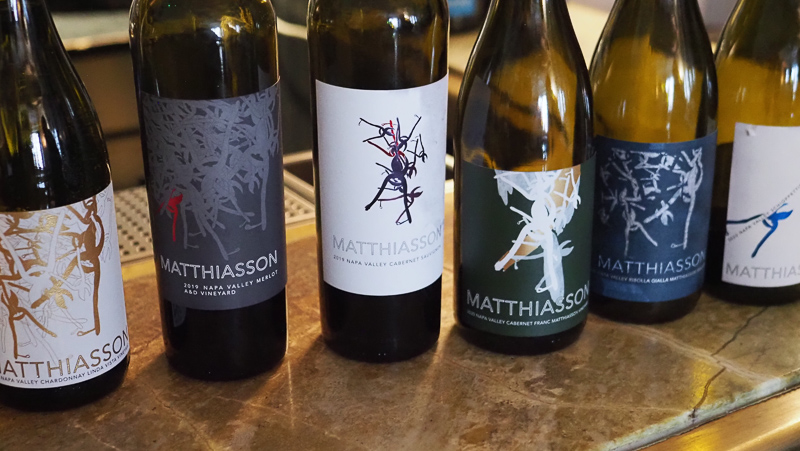
‘A couple of years back we went 100% no till with perennial grasses in all of our vineyards. Then in 2021 we had the worst drought in recorded history. The Linda Vista vineyard really suffered, and two years later we are just getting the vines back. It has been a process to recover them from the no till going into the drought. The vines couldn’t handle the competition. Some of it goes back to rooststock. In that vineyard it is SO4. It just can’t handle no-till and drought. These vines were planted in the 1980s and I don’t want to rip them out, because they make beautiful wine, as long as we cultivate in the rows in the spring. There we go back to our old school organic farming and plant a nice cover crop in the fall that grows with our winter rains, so we still get some good carbon sequestration because we aren’t tilling that deep. It’s not ideal, because we are tilling the top part, but you take what you can get.’
‘For the new vineyards that we are planting we can use a much stronger rootstock, and can do no-till dry farming because we can plan for it. We were overly idealistic when we took everything to no till: in hindsight that was a dumb move. Now we are about 60% no till, and we are happy with that, with our current rainfall patterns. Our winters aren’t cold, so the cover crop grows really lushly all winter. Then this is mowed or tilled in the spring. We can get a lot of growth in the winter.’
‘All cover crops are not equal. Most of the sustainable agriculture stuff also improves wine quality. To me, cover crop selection is as big as a deal as pruning when it comes to wine quality. Your choice of cover crop influences the vigour of the vine, and then biggest thing for wine quality is vine balance. If you have a vine grow just enough and not too much, and it lignifies its canes the right amount, and the clusters are the right weight, and there is the right amount of leaf area. If all this ties in, then bingo: the wine will be the best it can be in that place. In most of the really famous vineyards, one of the things they have going for them is that the vines are balanced. Cover crops are our brake and gas pedal to influence the capacity of that site. If the vines are weak, we go with lots of legumes to make lots of nitrogen. If they are really weak, we will till so they don’t have competition. And we’ll grow fava beans, winter peas, vetch and then some grains like oats or triticale, but we use a higher percentage of legume and lower percentage of grasses. We might use 60% legumes and 40% grains, and till them in early. If the vines are a little weak, we might use 30% legumes and 70% grains and till them in a little later.’
THE WINES
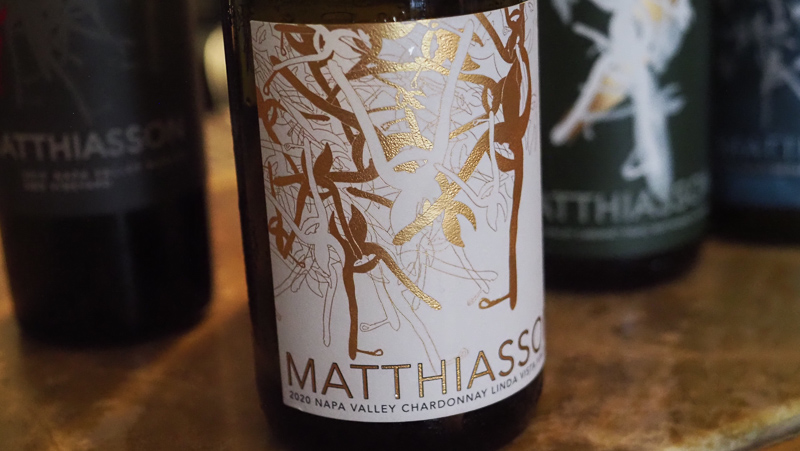
Matthiasson Chardonnay Linda Vista Vineyard 2020 Napa, California
Intense and fresh with nice bright apple and citrus, as well as some richer pear notes and some white peach. There’s a gentle spiciness from the oak. Nice harmony, good acidity and a tapering mineral finish. 94/100
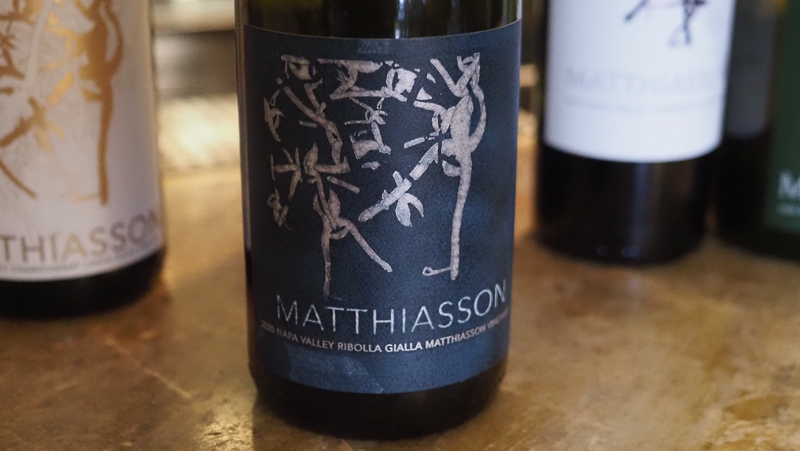
Matthiasson Ribolla Gialla 2019 Napa, California
This was direct pressed. Taut, fresh and linear with a lovely citrus core and a sense of harmony and transparency. Shows pear and white peach with a lovely acid line. Supple, fresh, fine and expressive. 93/100
Matthiasson Ribolla Gialla 2020 Napa, California
Skin fermented. Complex with apple, pear, honey and spice on the nose. Lively and structured with wonderful spicy complexity and tangy apple fruit, with some grip. Shows nice ripeness and purity, and vitality. 94/100
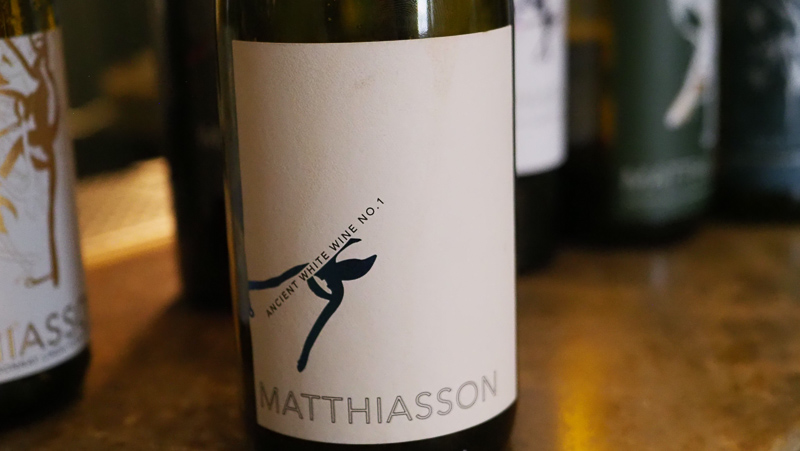
Matthiasson Ancient White Wine No 1 NV California
Steve and Jill met archaeologist Patrick McGovern who asked them whether they’ve ever tasted an ancient wine. This was the result of that conversation, a retsina combining Greco di Fufo with Aleppo pine sap, fermented on skins. Copper/bronze in colour, this is powerful, spicy and structured with firm tannins and a lovely acid line, showing apple, pear and lime notes. Intense and limey with a hint of mint, and some grip. 94/100
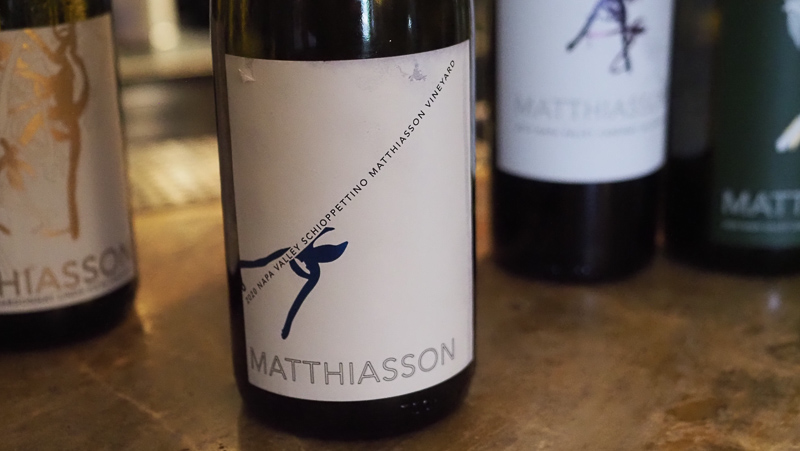
Matthiasson Schiopettino 2020 Napa, California
11% alcohol. A hard variety to grow: this gets diseases and also has metabolic disorders. They planted it because it was also called Ribolla Nero, but later they found out it isn’t related to Ribolla Gialla. Very supple, light and elegant with sweet peppery cherry and raspberry fruit as well as some sappy notes. Juicy and fine with a touch of rose petal, this is quite silky, but with some grip on the finish. 93/100
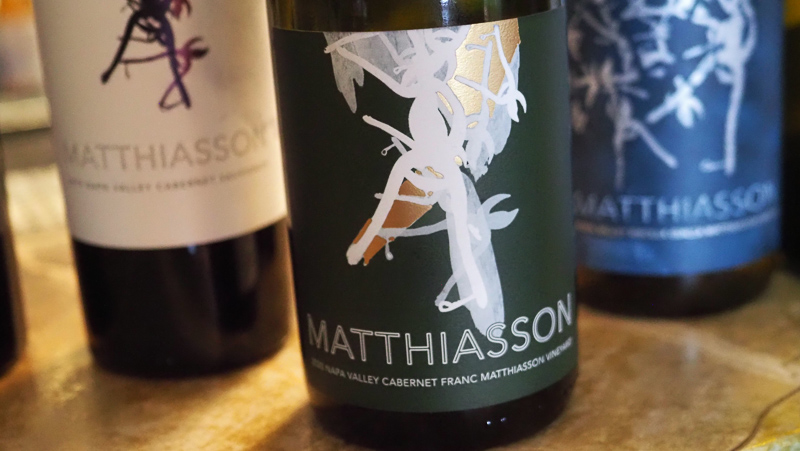
Matthiasson Cabernet France 2020 Napa, California
12% alcohol. This is from the home vineyard and is no-till, growing native Californian grasses. Chalky, fine, supple. Light but with plenty of flavour. Grainy, showing some grip, but also possessing massive drinkability. Such purity and finesse here. 95/100
Matthiasson Merlot 2019 Napa, California
From the Ashes and Diamonds vineyard, which is marine-based clay with some silt. Ripe, textured and sweetly fruited with some freshness. Lovely core of dense, sweet cherry and blackberry fruit with some nice texture. Sweet and generous. 93/100
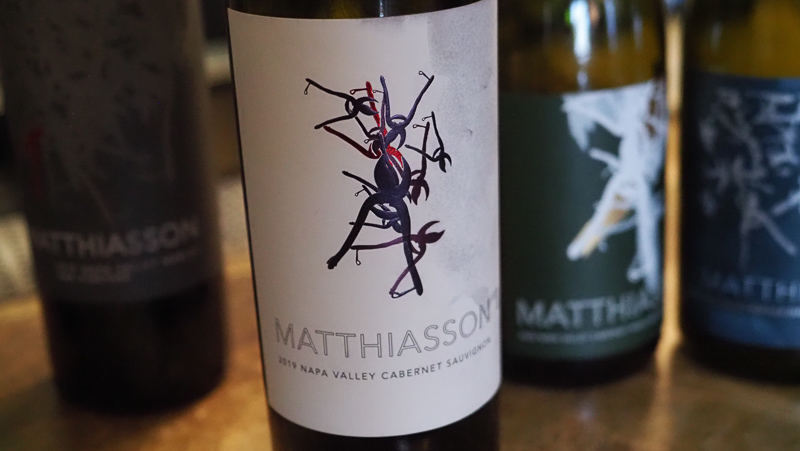
Matthiassion Cabernet Sauvignon 2019 Napa, California
13% alcohol. For seven years they didn’t make a Cabernet Sauvignon, but after this time they were ready to do one their way, from vineyards up and down Napa. Concentrated with lovely blackcurrant fruit and some sweetness here with a hint of mint, as well as some fine spiciness. Nice depth and richness with a black fruit core. Generous and expressive, with hints of olive and mint, as well as red fruits on the finish. 95/100
Older notes
Matthiasson Limerick Lane Vineyard White Wine 2014 Sonoma, California
11.8% alcohol. An interesting mix of Furmint and Harslevelu. Stony, waxy, nutty and quite mineral. The palate is really stony and has an interesting weight to it. Very textural. When this was in barrel Steve was worried that it didn’t have any flavour! 93/100
Matthiasson Napa Valley Chardonnay Linda Lista Vineyard 2014 California
12.8% alcohol. Clone 4 from clay soils. Half goes through malolactic. Very fresh, stony and a bit nutty with some nice pear, ripe apple and citrus fruit. There’s a bit of spiciness, too. Intense with real purity and a salty texture. 93/100
Matthiasson Sonoma Coast Chardonnay Michael Mara Vineyard 2014 California
Clone 4 from volcanic soils, 20 months in barrel, full malolactic. Richly textured and mineral, with some salty notes. Warm pear and spice. Lively and rounded with some stony, mealy notes and a rounded texture. 92/100
Matthiasson Napa Valley Semillon Ryan’s Vineyard 2012 California
This has a lovely citrus core with a hint of green. Nice texture with some freshness and a nice lemony finish. Herbal, salty and attractive. 92/100
Matthiasson Limerick Lane Vineyard Zinfandel 2013 Sonoma County, California
13.6% alcohol. Fresh and vital with nice bright raspberry and cherry fruit, with a bit of grip. Lovely structure with real freshness and purity. Bright red fruits dominate. 92/100
Matthiasson Napa Valley Schioppetino Matthiasson Vineyard NV California
This is a blend of 2013 and 2014 vintages. 11.9% alcohol. It’s a grape that’s hard to grow, as it is prone to mildew and shatter, but it’s Steve’s favourite of the wines he makes. Bright and aromatic with floral red cherries and pepper on the nose. Lively, vital and pretty with expressive red cherries on the palate. So fine and distinctive with lots of personality. 95/100
Matthiasson Napa Valley Cabernet Franc Matthiasson Vineyard 2012 California
Chalky, bright and fresh with nice raspberry and cherry fruit. Bright and a bit grippy with lovely purity. Very fine. 94/100
Matthiasson Napa Valley White Wine 2012 Napa Valley, California
A curious blend of Sauvignon Blanc, Ribolla Gialla, Semillon and Tocai Friulano that really works. Floral and pretty with aromas of herbs, tea, spice, grapes and melon. The palate is fresh, pure and detailed with nice finesse, and flavours of herbs, citrus peel, lemons and pith. 93/100
Matthiasson Cabernet Sauvignon 2011 Napa Valley, California
Steve Matthiasson describes this as ‘old school’, and says he’s copying the classic Napa Cabernet style, which was itself copying Bordeaux! It’s a truly brilliant wine, with a really fresh nose of blackcurrants and red fruits. The palate is fresh and detailed with grippy red fruits and some blackcurrant. Real precision here. The antithesis of super-sweet spoofulation. 95/100
UK agent: Nekter

